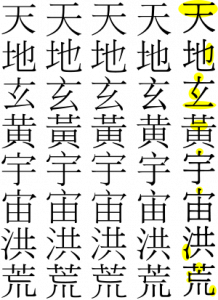Learning Chinese – tips and tricks. How to start learning Chinese
How to start learning Chinese
Nowadays, more and more people are coming to the decision to start learning Chinese. Everyone has their own way to this decision, but after making it, everyone wonders where to start learning Chinese? In this article, we have tried to collect basic tips and tricks for beginner sinologists.
The main thing is perseverance and patience, as in many other endeavors. As trite as it sounds, it’s true. This is probably true for Chinese, more than for any other language. To say that the language is difficult is to say nothing. But, as Chinese folk wisdom says, whoever wants, he will achieve.
Therefore, from the very beginning, tune in to the maximum investment of strength and dedication. First you need to understand what the Chinese language is. In fact, this is a collective concept. Different parts of China have their own dialects of the Chinese language, so phonetically different from each other that if speakers of different dialects try to talk to each other using each dialect, they simply will not understand each other. But if they take a piece of paper and write their words on it, then mutual understanding will be achieved.
Chinese hieroglyphic writing is common to all dialects, therefore they cannot be separated into separate languages, although the degree of their phonetic difference for such a distinction is more than enough. In order to have a universal means of communication throughout the country, the official state language of China, Putonghua (普通话 [pǔtōnghuà]), was developed on the basis of the most commonly used dialects.
This is the Chinese language that we foreigners usually learn. Of course, you can purposefully study one of the many Chinese dialects, but this must be due to some specific goals, for example, scientific ones. For you will spend an amount of effort comparable or incomparable to learning Putonghua, and you will be understood only in that part of China where this dialect comes from. And Putonghua is a universal variant of the Chinese language that is spoken (or should be spoken) anywhere in China.
Advanced segmentation controls
We’ve developed advanced segmentation controls so you can explore how Mandarin characters stick together to form words in sentences. Combine pinyin where words form and activate guides to divide the sentence into separate segments.
• All of the content in our examples is related to grammar points and sentence structure, as well as to the corresponding levels of HSK and CEFR. You know exactly what you’re reviewing.
• Enjoy one-touch settings to customize the levels you want to revise and select session size from 5 to 50 stages. Learn Chinese at your level at your own pace.
• Save interesting or useful sessions and return to them later. Access saved sessions, saved characters and saved grammar points right from the toolbar.
• Track your progress with personalized session statistics. Consistency is key to learning a language, so we’ve made it easy for you so you know exactly how you work.
• Schedule a time of the day and get notified when your grammar session ends. Keep Chinese fresh in your memory and never miss class.
The sound structure of the Chinese language.
Tones of the Chinese language It is worth starting the study with the concept of the sound system. The sound composition of the Chinese language is fundamentally different from the sound composition of our language family (Russian, English, German, Spanish, etc.).
This is how it is with us – the smallest sound unit is a sound, a letter corresponds to it in writing, syllables are formed from sounds, and words are formed from them. In the Chinese language, there is no concept of a letter, the minimum sound unit is a syllable, rigidly consisting of several specific sounds. In writing, a syllable corresponds to a hieroglyph. The number of syllables in Chinese is limited, in Putonghua it has 414.
Each syllable has a Latin spelling called pinyin (拼音 [pīnyīn]). First you need to familiarize yourself with the syllables and remember the pronunciation of each of them. We have prepared for you two versions of the syllable table, which differ in the way Chinese syllables are written in Russian letters. In the first version, the Russian reading is indicated according to the normative transcription system of Palladium.
This system is the standard for writing Chinese words (names of Chinese cities, surnames, etc.) in Russian letters in official Russian-language documents. But it just so happens that this system does not quite correctly convey some Chinese sounds, not the way the Chinese actually pronounce them in Mandarin.
Therefore, we have compiled the second version, where the Russian reading is indicated in terms of maximum compliance with the standard Chinese pronunciation. It doesn’t fully comply with Palladium’s normative transcription system, but it is how Chinese words should be pronounced. At the beginning of training, we recommend using the second option, as well as learning pronunciation with an experienced teacher or native speaker in order to get used to pronunciation as close to the norm as possible from the very beginning. Also, you can listen to audio recordings from tutorials. In addition, you can check out some more Chinese pronunciation tips.
Then, when you master the correct pronunciation, you will need to study the Palladium system. Why is this necessary if it does not correspond to the real Chinese pronunciation in everything? Then, in order to correctly write Chinese proper names in Russian. Maybe you will become a translator, and deviations from the norm in translations are unacceptable.
And just leaving messages on forums on the Internet, you also need to do it correctly, and not write, for example, Guangzhou, if Guangzhou is accepted, etc. At first glance, the difference is insignificant, but the norm is the norm, and for experienced Sinologists such errors immediately hurt the eye.
Tone is a characteristic of a syllable and has a meaningful function.
The same syllable, pronounced in different tones, has a different semantic meaning. Each of the 414 syllables can be pronounced in a different tone, which somewhat expands the phonetic range of the language. But even taking into account the presence of tones, the set of sounds still remains quite limited, which leads to a large number of homonyms in Chinese, when the same sound, even with one specific tone, can have a different meaning. In this case, the meaning is often determined from the context.
